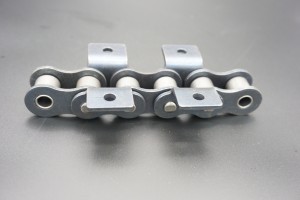Things to check before lubricating the roller chain
Appearance inspection:
Overall condition of the chain: Check whether there is obvious deformation on the chain surface, such as whether the chain link is twisted, whether the pin is offset, whether the roller is unevenly worn, etc. These deformations may affect the normal operation and lubrication effect of the chain.
Cleanliness of the chain: Check whether there is a lot of dust, oil, debris, etc. on the chain surface. If the chain is very dirty, it will not only affect the adhesion of the lubricant, but also accelerate the wear of the chain. It needs to be cleaned before lubrication.
Chain tension inspection: Too loose chain will cause tooth skipping and aggravate wear. Too tight chain will increase running resistance and stress. Generally, the verticality of the loose side of the chain for horizontal and inclined transmission should be about 1%-2% of the center distance, and it should be smaller in special cases such as vertical transmission or vibration load.
Sprocket inspection:
Sprocket wear: Check whether the tooth surface of the sprocket is excessively worn, deformed, cracked, etc. Abnormal wear of the tooth shape will accelerate chain damage, and the sprocket needs to be adjusted or replaced in time.
Matching of sprocket and chain: Ensure that the specifications of sprocket and chain match to avoid poor operation or excessive wear of the chain due to mismatch.
Lubrication system inspection (if any): Check whether the lubrication equipment is working properly, such as whether the lubricating oil pump, oil nozzle, oil pipe, etc. are blocked or leaking, and ensure that the lubrication system can evenly and smoothly deliver the lubricant to all parts of the chain.
Inspection items after roller chain lubrication
Lubrication effect inspection:
Observe the running status of the chain: Start the equipment, let the chain run idle for a while, and observe whether the chain runs smoothly, and whether there are abnormal noises, jitters, etc. If the lubrication is good, the chain should run smoothly and the noise is small; if there are still abnormalities, it may be insufficient lubrication or improper lubricant selection.
Check the link gap: After the equipment stops running, check the gap between the chain pin and the sleeve, and the gap between the roller and the sleeve, which can be measured with a feeler gauge. If the gap is too large, it means that the lubricant has not fully entered the gap or the lubrication effect is not good, and it is necessary to re-lubricate or find the cause.
Lubricant condition check:
Lubricant color and texture: Observe whether the color of the lubricant is normal, whether it has turned black, emulsified, etc., and whether the texture is uniform and whether there are impurities. If the lubricant deteriorates or is mixed with impurities, it needs to be replaced or cleaned in time and relubricated.
Lubricant distribution uniformity: Check whether all parts of the chain are evenly covered with a layer of lubricant, especially the inner side and link parts of the chain, which can be judged by observation or touch. If there is uneven lubrication, the lubrication method needs to be adjusted or relubricated.
Check for oil leakage: Check whether there are oil marks around the chain, sprockets, equipment connections, etc. If oil leakage is found, the oil leakage point needs to be found and repaired in time to prevent lubricant loss and environmental pollution.
Precautions for inspection before and after roller chain lubrication
Safety first: When checking before and after lubrication, be sure to ensure that the equipment has completely stopped running and cut off the power supply to prevent accidents. At the same time, operators should wear necessary protective equipment, such as gloves, goggles, etc.
Record and Analysis: After each inspection, the inspection results should be recorded in detail, including the tension of the chain, wear, use of lubricants, etc., so as to track and analyze the operation status of the roller chain, timely discover potential problems and take corresponding measures.
Regular inspection: The lubrication and inspection of the roller chain should be included in the daily maintenance plan of the equipment. According to the frequency of use and working conditions of the equipment, a reasonable inspection cycle should be formulated, such as a comprehensive inspection every week, month or quarter, to ensure that the roller chain is always in good operating condition.
By carefully doing the above inspections before and after the roller chain lubrication, potential problems can be discovered and solved in time, the service life of the roller chain can be extended, the operating efficiency and reliability of the equipment can be improved, the maintenance cost and downtime of the equipment can be reduced, and the production operation of the enterprise can be effectively guaranteed. At the same time, this is also an important content that international wholesale buyers are concerned about. Doing these things well will help enhance the competitiveness of enterprises in the market and win the trust and recognition of customers.
Post time: May-30-2025

